Page 13 of 386
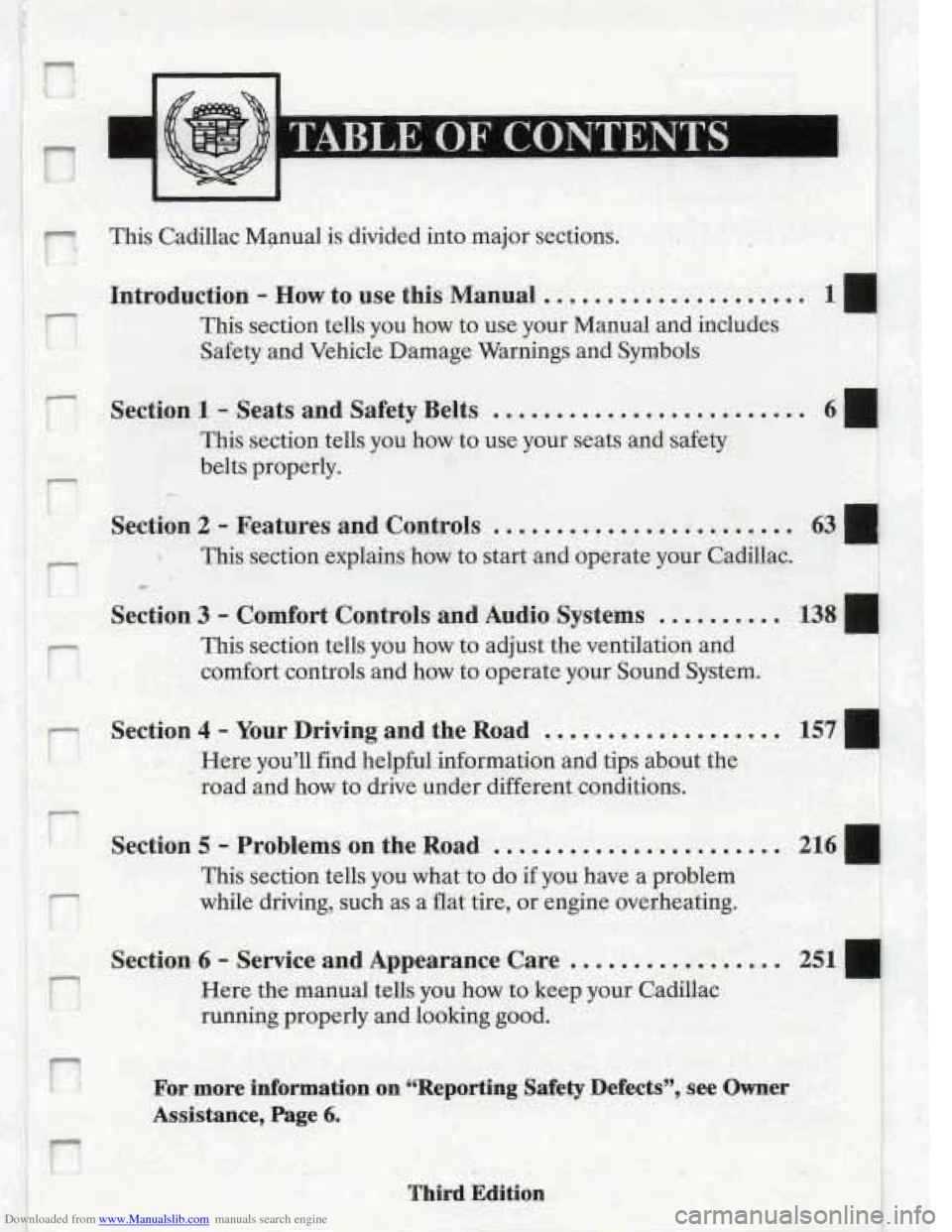
Downloaded from www.Manualslib.com manuals search engine r.
r !
r
This Cadillac Mpnual is divided into major sections.
Introduction - How to use this M,anual. .......... ..........
This section tells you how to use your Manual and includes
Safety and Vehicle Damage Warnings and Symbols I ~
Section 1 - Seats and Safety Belts .........................
This section tells you how to use your seats and safety
belts properly.
.--
Section 2 - Features and Controls .................. .A .... 63 :q
Section 3 - Comfort Controls and Audio Systems .......... 138.4
3 This section explains how to start and operate your Cadillac.
c
This section tells you how to adjust the ventilation and
comfort controls and how to operate your Sound System.
section 4 - Your Driving and the Road ................... 157
,. . Here you’ll. find helpful information and tips about the: ..
road and how to drive under different conditions.
Section 5 - Problems on the Road ....................... 216 4
This section tells you what to do if you have a problem
while driving, such as a flat tire, or engine overheating. ,
I
Section16 - Service and Appearance Care .................
Here the manual tells you how to keep your Cadillac !
running properly and looking good.
For more information on CCReporting Safety Defects”, .see Owner
Assistance, Page 6.
Page 25 of 386
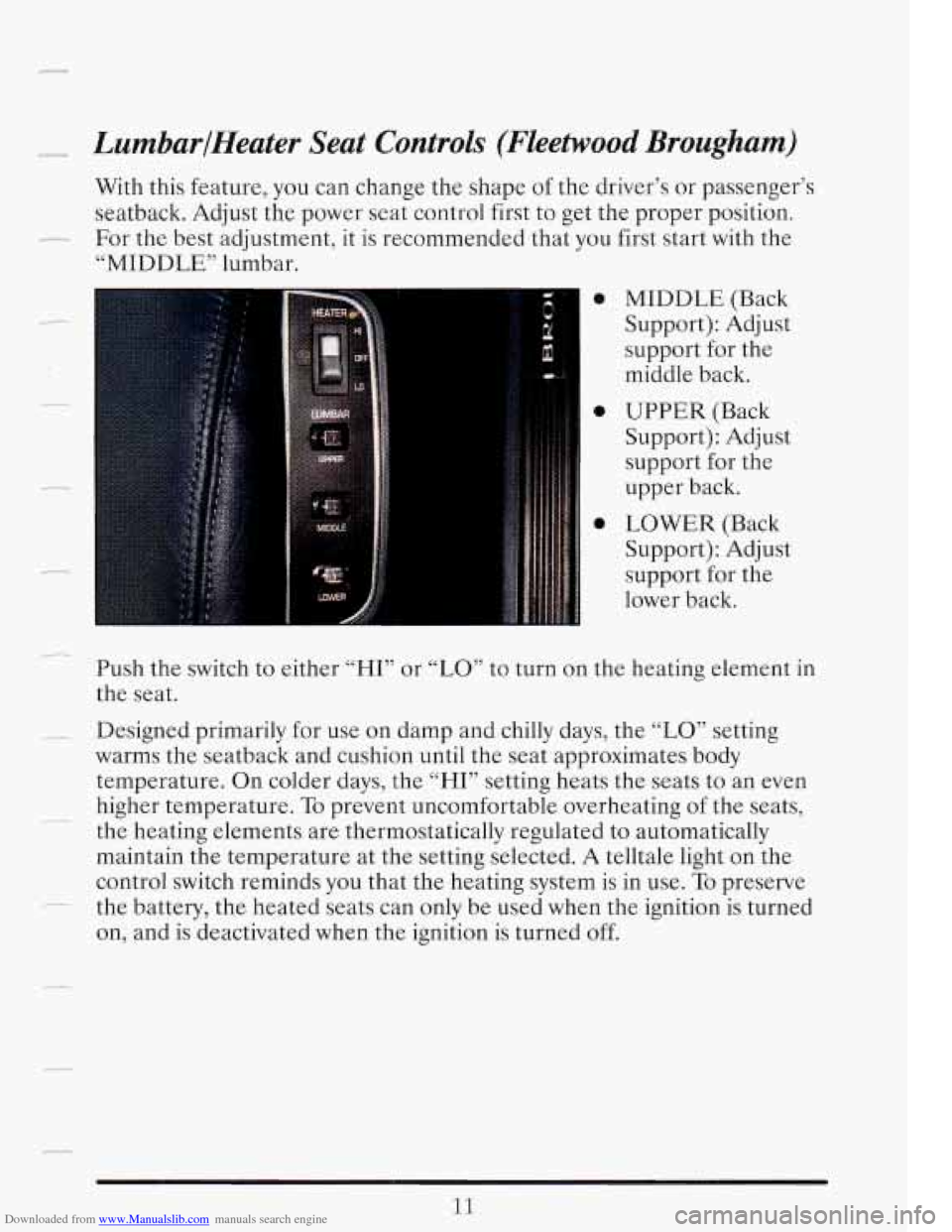
Downloaded from www.Manualslib.com manuals search engine _1“4 LumbarlHeater Seat Controls (Fleetwood Brougham)
With this feature, you can change the shape of the driver’s or passenger’s
seatback. Adjust the power seat control first to get the proper position.
For the best adjustment, it is recommended that you first start with the
“MIDDLE” lumbar.
0
0
0
MIDDLE (Back
Support): Adjust
support for the
middle back.
UPPER (Back
Support): Adjust
support
for the
upper back.
LOWER (Back
Support): Adjust
support for the
lower back.
-.
Push the switch to either “HI” or “LO” to turn on the heating element in
the seat.
- .- Designed primarily for use on damp and chilly days, the “LO” setting
warms the seatback and cushion until the seat approximates body
temperature. On colder days, the
“HI” setting heats the seats to an even
__ higher temperature. To prevent uncomfortable overheating of the seats,
the heating elements are thermostatically regulated to automatically
maintain the temperature at the setting selected. A telltale light on the
control switch reminds you that the heating system is in use.
To preserve
the battery, the heated seats can only be used when the ignition is turned
on, and is deactivated when the ignition is turned off.
--
11
Page 134 of 386
Downloaded from www.Manualslib.com manuals search engine Other Ashtrays
Here's how to remove them:
NOTICE:.
..-
Do& -put papers or t,Lller flfrlllmable things into your ashtray
Hot cigarettes
or other SII- -%ng material
causing a damaging
.. fire.
CIGmTTE LIGHTER
It's near the ashtray. To use a lighter, just push it all the way in. When it's
ready, it will pop back by itself.
I
heating, it won't be able to back away from the heating element
ken
it's ready. That can
and the heating element.
120
a
I
LJ
n
Page 143 of 386
Downloaded from www.Manualslib.com manuals search engine HOT COOLANT CAN BURN YOU BADLY!
In “Problems on the Road,’’ this manual shows what to do. See “Engine
Overheating”
in the Index.
1
1 I LNl Prere Light
This light tells you if
there couldbe a
i+gg&dea with your
engine oil pressure.
i
I Don’t keep driving if the oil pressure is low. If you do, your
engine can become
so hot that it catches fire. You or others
could be burned. Check your oil as soon as possible and have
your vehicle serviced.
i I’
I
- ~-...
129
Page 153 of 386
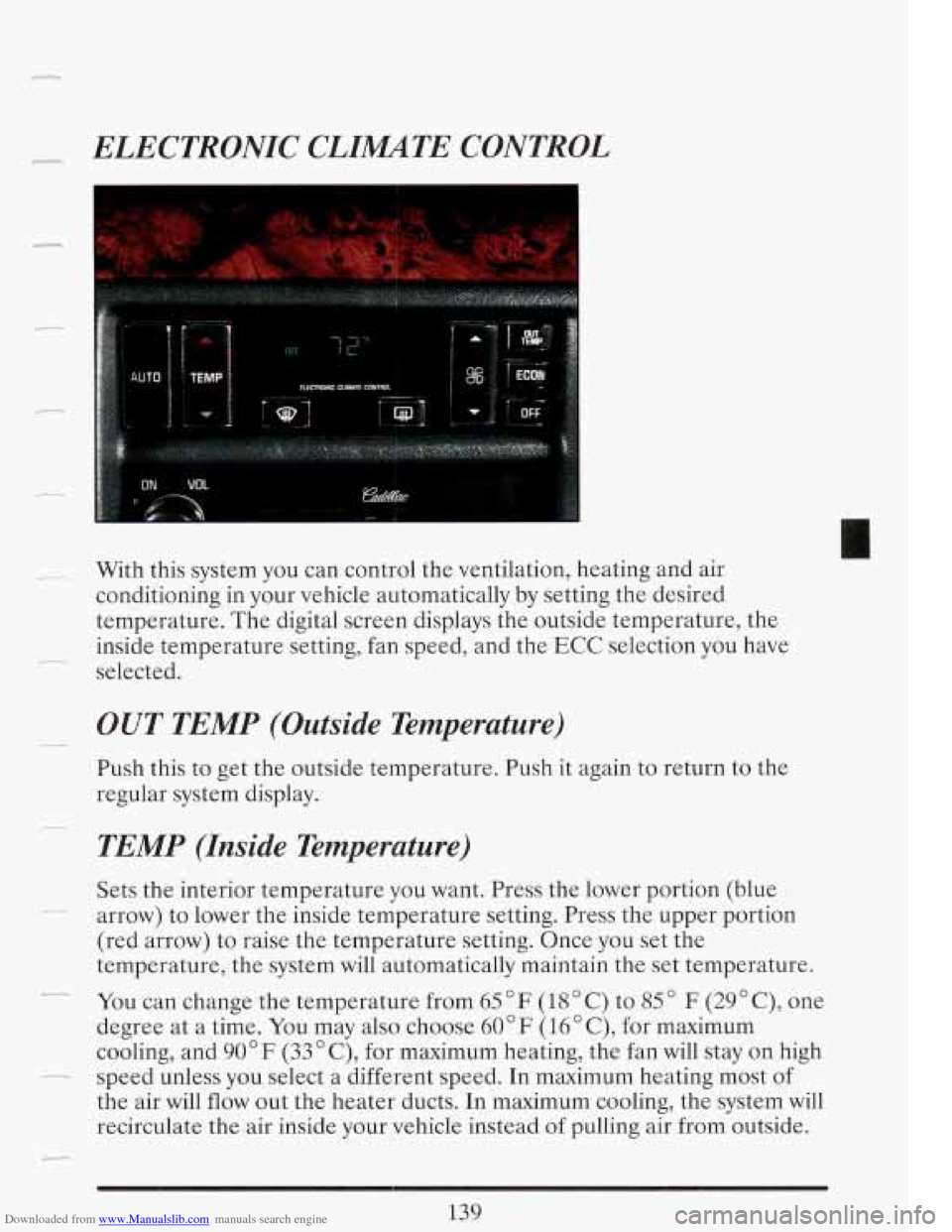
Downloaded from www.Manualslib.com manuals search engine ELECTRONIC CLIMTE CONTROL
With this system you can control the ventilation, heating and air
conditioning in your vehicle automatically by setting the desired
temperature. The digital screen displays the outside temperature, the
inside temperature setting, fan speed, and the ECC selection you have
selected.
OUT TEMP (Outside Temperature)
Push this to get the outside temperature. Push it again to return to the
regular system display.
TEMP (Inside Temperature)
Sets the interior temperature you want. Press the lower portion (blue
arrow) to lower the inside temperature setting. Press the upper portion
(red arrow) to raise the temperature setting. Once you set the
temperature, the system will automatically maintain the set temperature.
You can change the temperature from
65 " F (18 " C) to 85 " F (29' C), one
degree at a time. You may also choose
60 " F (16 " C), for maximum
cooling, and
90°F (33" C), for maximum heating, the fan will stay on high
the air will flow out the heater ducts. In maximum cooling, the system will
recirculate the air inside your vehicle instead
of pulling air from outside.
- -.
-
- speed unless you select a different speed. In maximum heating most of
Page 228 of 386
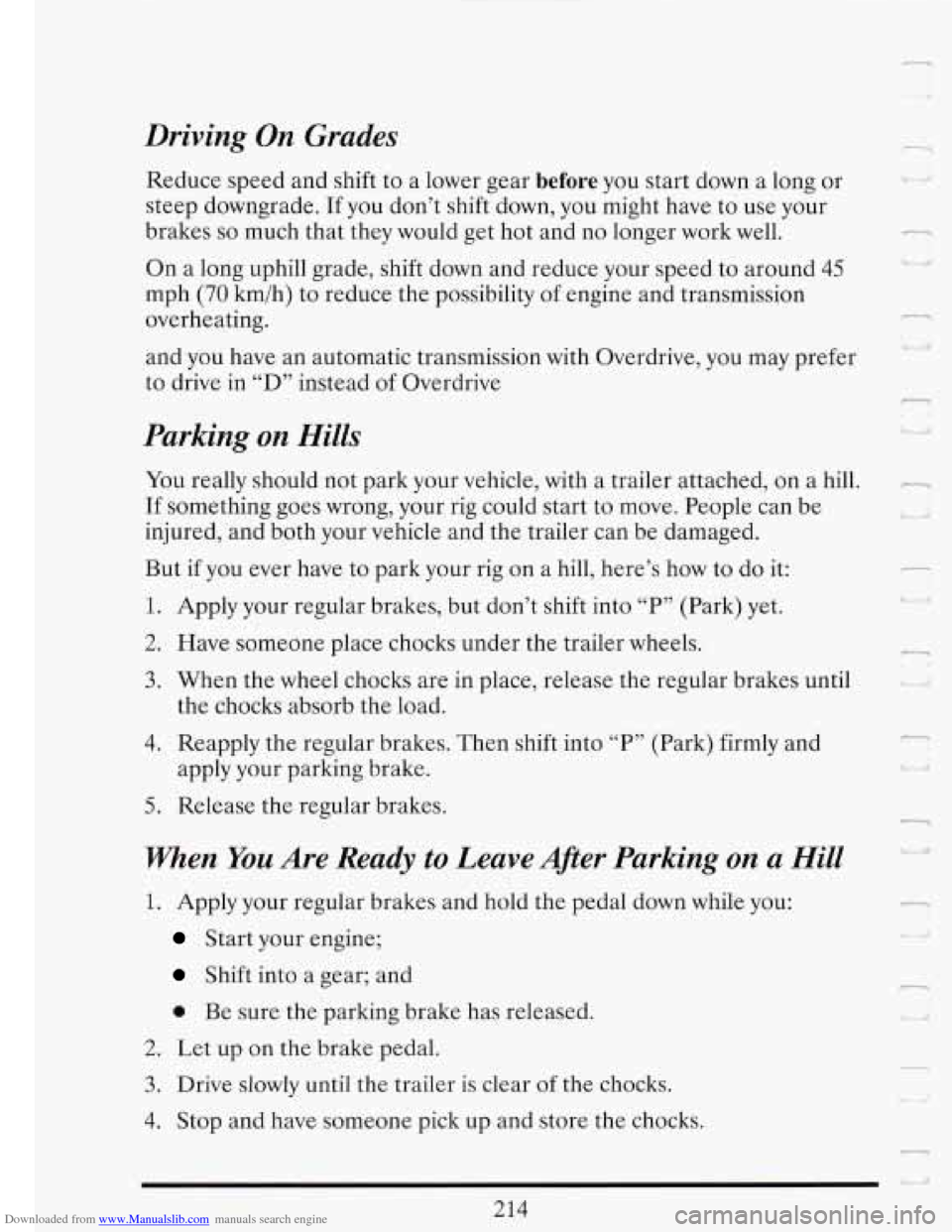
Downloaded from www.Manualslib.com manuals search engine Driving On Grades
Reduce speed and shift to a lower gear before you start down a long or
steep downgrade. If you don’t shift down, you might have to use your
brakes
so much that they would get hot and no longer work well.
On a long uphill grade, shift down and reduce your speed to around 45
mph (70 kmih) to reduce the possibility of engine and transmission
overheating.
19 1
d l
n 1, ia
and you have an automatic transmission with Overdrive, you may prefer
to drive in
“D” instead of Overdrive
Parking on Hills
You really should not park your vehicle, with a trailer attached, on a hill. -
If something goes wrong, your rig could start to move. People can be
injured, and both your vehicle and the trailer can be damaged. <-
But if you ever have to park your rig on a hill, here’s how to do it:
1. Apply your regular brakes, but don’t shift into “P” (Park) yet.
2. Have someone place chocks under the trailer wheels.
3. When the wheel chocks are in place, release the regular brakes until
4. Reapply the regular brakes. Then shift into “P” (Park) firmly and
apply your parking brake.
5. Release the regular brakes.
the
chocks absorb the load.
When You Are Ready to Leave After Parking on a Hill
1. Apply your regular brakes and hold the pedal down while you:
Start your engine;
Shift into a gear; and
0 Be sure the parking brake has released.
2. Let up on the brake pedal.
3. Drive slowly until the trailer is clear of the chocks.
4.
Stop and have someone pick up and store the chocks.
r .t
-1
L
e_i
u
,. .
214
Page 244 of 386
Downloaded from www.Manualslib.com manuals search engine The coolant level should be at or above “FULL COLD.” If it isn’t, you
may have a leak in the radiator hoses, heater hoses, radiator, water pump
or somewhere else
in the cooling system.
A CAUTION:
Heater and radiator hoses, and other engine parts, can be very
hot. Don’t touch them.
If you do, you can be burned.
Don’t run the engine if there
is a leak. If you run the engine, it
could lose all coolant. That could cause an engine fire, and you
could be burned. Get any leak fixed before you drive the vehicle.
-
1. .
If there seems to be no leak, check to see if the fan or if equipped electric --
engine fans are running. If the engine is overheating, both fans should be
running.
If they aren’t, your vehicle needs service.
Page 307 of 386
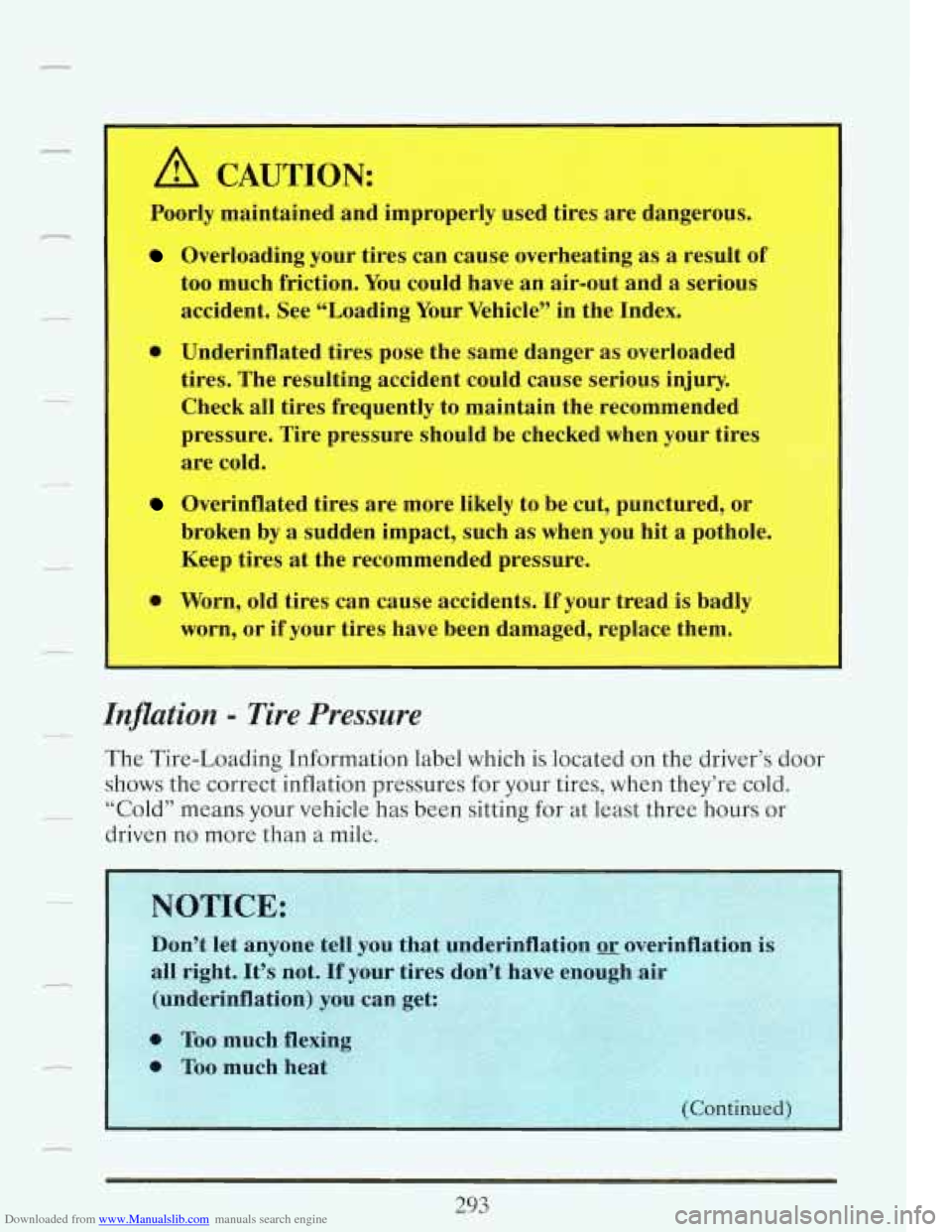
Downloaded from www.Manualslib.com manuals search engine A CAUTION:
i --
Poorly maintained and improperly used tires are dangerous.
Overloading your tires can cause overheating as a result of
I
too much friction. You could have an air-out and a serious
accident. See “”Loading Your Vehicle” in the Index.
0 Underinflated tires pose the same danger as overloaded
tires. The resulting accident could cause serious injury.
Check all tires frequently
to maintain the recommended
pressure. Tire pressure should
be checked when your tires
are cold.
I
I Overinflated tires are more likely to be cut, punctured, or
broken by
a sudden impact, such as when you hit a pothole.
Keep tires at the recornmended pressure.
@ Worn, old tires can cause accidents. If your tread is badly
worn, or if your tires have been damaged, replace them.
Inflation - Tire Pressure _c
The Tire-Loading Information label which is located on the driver’s door
shows the correct inflation pressures
for your tires, when they’re cold.
driven no more than a mile.
- “Cold’’ means your vehicle has been sitting for at least three hours or
293